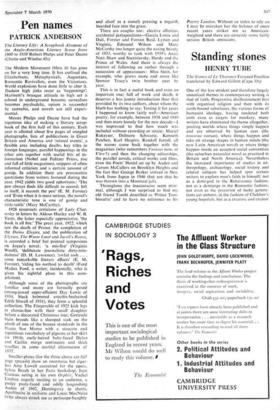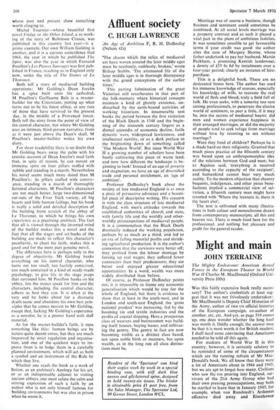Standing stones
HENRY TUBE
The Stones of Le Thoronet Fernand Pouillon translated by Edward Gillott (Cape 35s) One of the less strident and therefore largely unnoticed themes in contemporary writing is that of faith. Progressive disillusionment first with organised religion and then with its earth-bound substitutes, the various forms of humanist ideology, having rendered both unfit even as targets for mockery, many writers have eliminated the theme altogether, positing worlds where things simply happen and are observed by human eyes (the nouveau roman), where things happen and take on strange shapes in human minds (the new Latin American novel) or where things happen inside an accepted social convention (the suburban naturalist novel as practised in Britain and North America). Nevertheless the increased importance of studies in an- thropology, archaeology, social history and related subjects has helped spur certain writers to explore man's faith in himself; not as a demi-god in the Renaissance fashion, not as a demiurge in the Romantic fashion, not even as the precursor of lucky genera- tions yet unborn, in the fashion of Chekhov's young hopefuls, but as a creature and creator whose past and present show something worth clinging to.
Michel Tournier—whose beautiful first novel Friday or the Other Island, a re-work- ing of the story of Robinson Crusoe, was published in this country last year—is a prime example. Our own William Golding is another, and it is a curious coincidence that 1964, the year in which he published The Spire, was also the year in which Fernand Pouillon's Les Pierres Sauvages was first pub- lished in France, reaching us in England only now, under the title of The Stones of Le Thoronet.
Both tell a story of mediaeval building operations: Mr Golding's Dean Jocelin has a spire built onto his cathedral, M Pouillon's Guillaume Balz is a master- builder for the Cistercians, putting up what turns out to be his finest abbey, at any rate of those that have survived to the present day, in the middle of a Provencal forest.
Both tell the story from the point of view of the central character, but where Mr Golding uses an intimate third-person narrative, from as it were just above the Dean's skull, M Pouillon's master-builder- writes his own diary.
For sheer readability there is no doubt that Mr Golding bears away the palm with his ecstatic account of Dean Jocelin's mad faith that, in spite of reason, he can mount an immense spire on four pillars stuffed with rubble and standing in a marsh. Nevertheless his novel seems much more dated than M Pouillon's: its pillars stuffed with contriv- ance, standing in a marsh of thoroughly fictional characters. M Pouillon's characters are not much better, large two-dimensional cut-outs of the Friar Tuck variety, all big hearts and little human failings, but his book is really a solid and detailed description of the building from scratch of the abbey of Le Thoronet, to which he brings his own experience as a practising architect. The fact that all is viewed through the invented mind of the builder makes this a novel and the fact that all the stages and set-backs of the building are made to reflect this character's peculiarity, to chart his faith, makes this a good and for the most part genuine novel.
The difference here is perhaps only in the degree of objectivity. Mr Golding banks everything on his central character, who turns out too small, too facilely conceived, too much contained in a kind of ready-made psychology, to give life to the stage props that surround him. M Pouillon banks on his abbey, lets the stones speak for him and the characters, including the central character, adhere as best they can. It is when at the very end he looks about for a dramatic death-scene and abandons his own best prin- ciples that he comes nearest to Mr Golding, except that, lacking Mr Golding's experience as a novelist, he is a poorer hand with duff material.
As for the master-builder's faith, it runs something like this: human beings are by nature quite decent coves, but they are much improved by strict regulation and organisa- tion, and one of the quickest ways to im- prove them is to lodge them in a carefully planned environment, which will act as both a symbol and an instrument of the Rule by which they live.
Whether one reads the book as a work of fiction, as an architect's Apology for his art, or as an indispensable adjunct to visiting ancient abbeys, one must salute the calm and stirring expression of such a faith by an author who is not only himself famous for building environments but was also in prison when he wrote it.



































 Previous page
Previous page